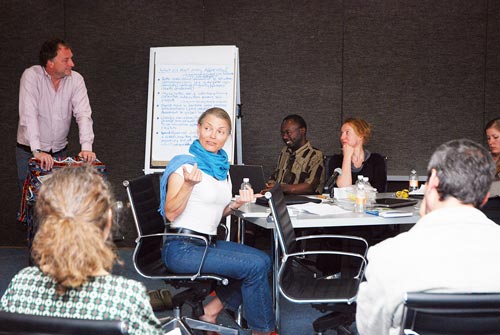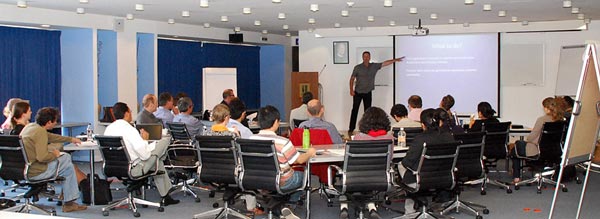 On daily basis, we interact with farmers, extension workers, researchers, seed companies, government officials, and many others. Our work would not be possible without these actors, many of whom focus on bringing new products, new processes, new policies, and new forms of organization into economic use. In their attempts to bring about change in agriculture, these multiple stakeholders are all part of what may be seen as agricultural innovation systems (AIS). However, CIMMYT’s engagement with AIS and its role within innovation platforms was not discussed more closely until recently. To review CIMMYT’s role and current approach to the AIS framework, summarize what has been done, and touch upon future plans, CRP MAIZE, the Global Conservation Agriculture Program (GCAP), and the Royal Tropical Institute (KIT) organized a workshop on “Agricultural Innovation Systems: what does it mean to the work we do?” The day-long event took place at CIMMYT-El Batán on 11 April 2013; it was attended by over 30 participants from several CIMMYT departments, programs, and regional offices, and facilitated by Remco Mur and Mariana Wongtschowski from KIT.
On daily basis, we interact with farmers, extension workers, researchers, seed companies, government officials, and many others. Our work would not be possible without these actors, many of whom focus on bringing new products, new processes, new policies, and new forms of organization into economic use. In their attempts to bring about change in agriculture, these multiple stakeholders are all part of what may be seen as agricultural innovation systems (AIS). However, CIMMYT’s engagement with AIS and its role within innovation platforms was not discussed more closely until recently. To review CIMMYT’s role and current approach to the AIS framework, summarize what has been done, and touch upon future plans, CRP MAIZE, the Global Conservation Agriculture Program (GCAP), and the Royal Tropical Institute (KIT) organized a workshop on “Agricultural Innovation Systems: what does it mean to the work we do?” The day-long event took place at CIMMYT-El Batán on 11 April 2013; it was attended by over 30 participants from several CIMMYT departments, programs, and regional offices, and facilitated by Remco Mur and Mariana Wongtschowski from KIT.
What led to this cooperation between KIT and CRP MAIZE? When presented with the challenges of CRP MAIZE, such as lifting 10 million people out of extreme poverty in 10 years, David Watson, CRP MAIZE program manager, realized that innovations systems and innovation platforms are often seen as key in achieving these high-aiming goals. “I looked on the ground, but there was no explicit agricultural innovation expertise,” Watson said, explaining why CRP MAIZE contacted KIT to take stock of innovation platform structures and operation processes in CRP MAIZE projects, and suggest ways to strengthen the AIS approach and multi-stakeholder interaction structures.
Wongtschowski presented some of the KIT report findings. Addressing the strong technology focus of CIMMYT, she stressed that innovation is not only about developing technology, but also about setting up mechanisms that would put the technology into practice. “Innovation emerges from interaction,” Wongtschowski added, casting more light on the potential role of CIMMYT, “and while researchers may play a role, their role isn’t the most important one.” Jens Andersson, CIMMYT innovation systems scientist based in Zimbabwe, provided a reflection on the KIT report focusing on the implications of adopting an AIS framework for CIMMYT’s organization of research and its partnerships. “At CIMMYT, we look at innovation platforms as a means to reach impact at scale, or as a vehicle for technology transfer,” he said; but, as the report states, feedback loops from farmers and other stakeholders back to the researchers are often missing. At the same time, innovation platforms play a key role in articulating demand for research within the AIS framework. Yet, as Andersson pointed out, there are a number of problematic assumptions about how stakeholders interact within such platforms. For example, it is generally assumed that once an innovation platform has been established, stakeholders can voice their demands. “We have to be wary of those who talk very little,” Andersson said, alluding to the often silent majority of women farmers in meetings. “They might talk little because they can’t express their ideas,” he explained, pointing to the continued role of research in identifying demand. Then he followed with a photograph from first-year on-farm trial plots under conventional ridgeand- tillage and conservation agriculture in southern Africa. Against all expectation, the maize on the conservation agriculture plot was significantly taller than the conventionally grown maize, despite the same fertilizer regime and the absence of soil cover and nitrogen-mineralizing soil tillage in the conservation agriculture treatment. Behind this mystery lies another assumption about stakeholder participation: are farmers participating in researchers’ field trials because of their keen interest in a technology package, or do they have other reasons? In this case, the trialhosting farmer ‘helped’ the researcher by deliberately planting the conventional treatment late so that the researcher’s treatment would look better. The farmer sought to secure the farm inputs supplied to him also for next season. In this area, farmers’ biggest struggle is to source expensive inputs, notably fertilizer, and the input-supported trials of the researcher provided an opportunity. Farmer participation was thus motivated by a constraint beyond the field scale. “If we don’t research and understand how the wider system works, we can’t effectively introduce new technologies,” Andersson concluded his argument for a system-oriented research.
The workshop’s morning section was wrapped up with a group discussion on the changes necessary for successful innovation. Participants discussed and presented their ideas on what could be improved in our daily work regarding AIS. One question recurred several times during the lively discussions: is it our role to always be the facilitator within innovation platforms, or should this role be carried out by farmers’ associations or other actors?
The afternoon session was devoted to presentations by Bram Govaerts, leader of the Take it to the Farmer component of MasAgro, and Michael Misiko, GCAP innovation specialist, who focused on innovation platforms and their components within Take it to the Farmer and SIMLESA, respectively. While providing an overview of Take it to the Farmer, Govaerts stressed the importance, complexity, and history of farmer organizations as parts of agricultural innovation systems, reiterating Andersson’s previous statement on the importance of understanding the system. Misiko focused on the forms of and need for innovation platforms within SIMLESA. The foundations of SIMLESA lie on integration and partnerships of systems and institutions, sustainable innovation, and impact. However, the organizations operating within SIMLESA are often poorly clustered, sometimes completely detached from the commodities with which they work. According to Misiko, the next step towards further efficiency of the project is a higher level of integration of institutions within SIMLESA’s innovation platform systems.
Bruno Gerard, GCAP director, and Watson, concluded the workshop with reflections on AIS and their roles. “Innovation platforms and innovation approaches should not be taken as the next silver bullet to achieve impact scale,” said Gerard. “They are a mean rather than an end. They are critical for better understanding of social processes within farming systems and for putting technical innovations in context as they can provide important missing knowledge for researchers, farmers, and other actors, including the private sector, in a co-learning fashion.” Gerard pointed out some of the drawbacks as well; innovation platforms and approaches are often resource-intensive and difficult to scale out and scale up due to their context-specificity. “But they can generate valuable, more generic lessons on adoption, adoptability, and the way forward,” he added. “As researchers we have to be careful to intervene more as a catalyst and honest broker and not be too central in order to achieve positive long-term changes. We have to think of a good exit strategy from the beginning. At GCAP, innovations approaches are one piece of the puzzle within our systems research framework and impact pathways,” Gerard concluded.
 Innovations
Innovations 
